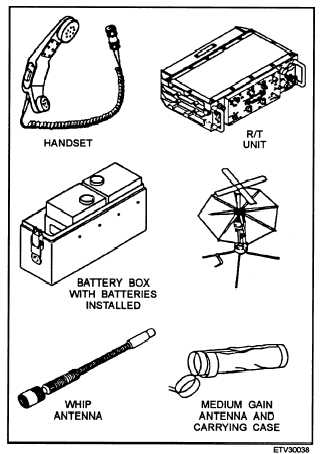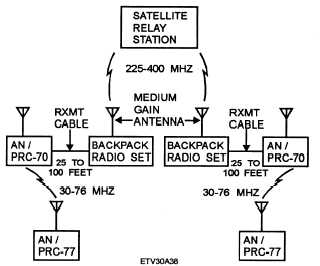frequency hopping, no single carrier is used. Instead,
the transmitter hops around the band in a random
pattern, spending only a few milliseconds on any one
frequency. This makes the signal difficult to detect and
extremely difficult to monitor or jam.
AN/PSC-3
Backpack radio set AN/PSC-3 is a portable,
battery-powered, half-duplex uhf transceiver operat-
ing in the 225.0- to 399.995-MHz range. It provides
two-way voice (secure and plain) and data com-
munications via satellite relay (SAT) or line-of-sight
(los) modes. Radio set AN/PSC-3 components are
shown in figure 2-26.
One important feature of the AN/PSC-3 is its
ability to interface directly with the AN/PRC-70,
AN/PRC-77, and other vhf-capable radios, which
provides a satellite link for vhf tactical equipment.
This provides away to retransmit vhf information from
one of these radios by (1) converting vhf to uhf, (2)
transmitting through a satellite to another AN/PRC-3,
(3) demodulating it and passing it directly to another
Figure 2-26.—Radio Set AN/PSC-3.
2-28
AN/PRC-70/77, which could then (4) retransmit the
information as vhf. This greatly enhances com-
munications capability and extends the com-
munications range. A basic retransmission setup is
shown in figure 2-27.
DIGITAL MESSAGE DEVICE GROUP
(DMDG)
The DMDG is part of the Special Forces Burst
Communications System. It is used with radio sets
AN/PRC-70/74 and AN/PSC-3 to send and receive
messages. Messages are typed on the KY-879/P
keyboard (shown in figure 2-28), which displays the
message as it is being typed and stored in memory.
When the message is ready to be sent, the operator
selects the proper mode and the device converts the
message to digital information. The digital in-
formation is sent to one of the above radios for
transmission. After the information is received at the
other end, it is sent to another KY-879/P, where the
message can be read on the device’s display screen.
The device can send messages at 300 or 1200 baud
in the satellite mode and 266.6 baud when connected to
the AN/PRC-70/74.
INTRODUCTION TO
COMMUNICATIONS LINK
INTERFACE PLANNING SYSTEM
(CLIPS)
The Communications Link Interface Planning
System (CLIPS) was introduced to the Joint Special
Operations Community in 1986. CLIPS is a system
designed to help the communications planner
Figure 2-27.—Basic retransmission scheme.



